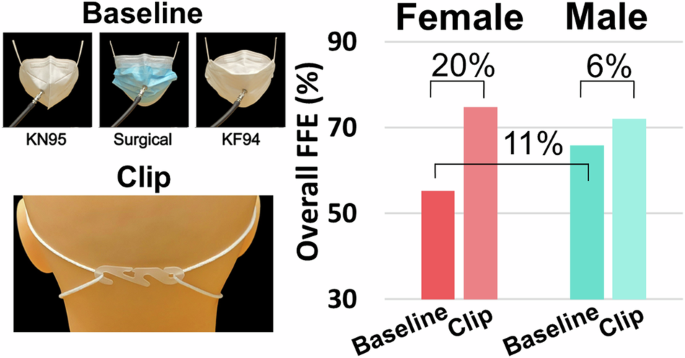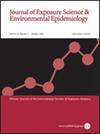一次性口罩的过滤效率因性别而异。
IF 4.7
3区 医学
Q2 ENVIRONMENTAL SCIENCES
Journal of Exposure Science and Environmental Epidemiology
Pub Date : 2024-07-02
DOI:10.1038/s41370-024-00697-4
引用次数: 0
摘要
背景和目的:一次性口罩是防止接触传染性和有毒气溶胶(如空气中的病毒和微粒空气污染物)对健康造成不良影响的主要防护措施。虽然高效呼吸器的佩戴在职业环境中受到监管,但人们对公众佩戴的耳环式口罩的过滤效率却知之甚少:我们采用美国职业安全与健康管理局的密合度定量测试方法,对 N95(呼吸器)、KN95、外科口罩和 KF94 口罩的密合过滤效率(FFE)进行了测量,测量对象为一组健康的成年参与者(N = 100,50% 女性,50% 男性,平均年龄 = 32.3 ± 9.2 岁,平均体重指数 = 25.5 ± 3.4)。此外,还对后三种耳环式口罩进行了夹子改良测试,使用塑料夹子将耳环集中固定在后脑勺:结果:研究结果表明,性别是 KN95、手术和 KF94 口罩 FFE 的主要决定因素。在基线测试中,男性的 FFE 平均比女性高 11%。我们的研究表明,使用耳环夹进行简单的改装就能提高女性的平均 FFE 值,而男性的变化相对较小。将夹子戴在脑后时,女性的 FFE 平均增加了 20%,而男性只增加了 6%:影响:一次性口罩对空气污染物的防护效果取决于口罩材料的效率以及与佩戴者的贴合程度。我们的报告显示,佩戴者的性别是决定常用耳环式口罩基线贴合过滤效率(FFE)的主要因素。此外,我们的研究还表明,一个简单的密合度调节器--一个固定在脑后的耳环夹--可大幅提高女性的基线过滤效率,但对男性来说变化不大。这些发现对使用口罩作为吸入空气污染物的保护性干预措施具有重要的公共卫生意义。本文章由计算机程序翻译,如有差异,请以英文原文为准。


Variation in the fitted filtration efficiency of disposable face masks by sex
Disposable face masks are a primary protective measure against the adverse health effects of exposure to infectious and toxic aerosols such as airborne viruses and particulate air pollutants. While the fit of high efficiency respirators is regulated in occupational settings, relatively little is known about the fitted filtration efficiencies of ear loop style face masks worn by the public. We measured the variation in fitted filtration efficiency (FFE) of four commonly worn disposable face masks, in a cohort of healthy adult participants (N = 100, 50% female, 50% male, average age = 32.3 ± 9.2 years, average BMI = 25.5 ± 3.4) using the U.S. Occupational Safety and Health Administration Quantitative Fit Test, for an N95 (respirator), KN95, surgical, and KF94 masks. The latter three ear loop style masks were additionally tested in a clip-modified condition, tightened using a plastic clip to centrally fasten loops in the back of the head. The findings show that sex is a major determinant of the FFE of KN95, surgical, and KF94 masks. On average, males had an 11% higher FFE relative to females, at baseline testing. We show that a simple modification using an ear loop clip, results in improvements in the average FFE for females but provides comparatively minor changes for males. On average, females had a 20% increased FFE when a clip was worn behind the head, relative to a 6% increase for males.
求助全文
通过发布文献求助,成功后即可免费获取论文全文。
去求助
来源期刊
CiteScore
8.90
自引率
6.70%
发文量
93
审稿时长
3 months
期刊介绍:
Journal of Exposure Science and Environmental Epidemiology (JESEE) aims to be the premier and authoritative source of information on advances in exposure science for professionals in a wide range of environmental and public health disciplines.
JESEE publishes original peer-reviewed research presenting significant advances in exposure science and exposure analysis, including development and application of the latest technologies for measuring exposures, and innovative computational approaches for translating novel data streams to characterize and predict exposures. The types of papers published in the research section of JESEE are original research articles, translation studies, and correspondence. Reported results should further understanding of the relationship between environmental exposure and human health, describe evaluated novel exposure science tools, or demonstrate potential of exposure science to enable decisions and actions that promote and protect human health.

 求助内容:
求助内容: 应助结果提醒方式:
应助结果提醒方式:


